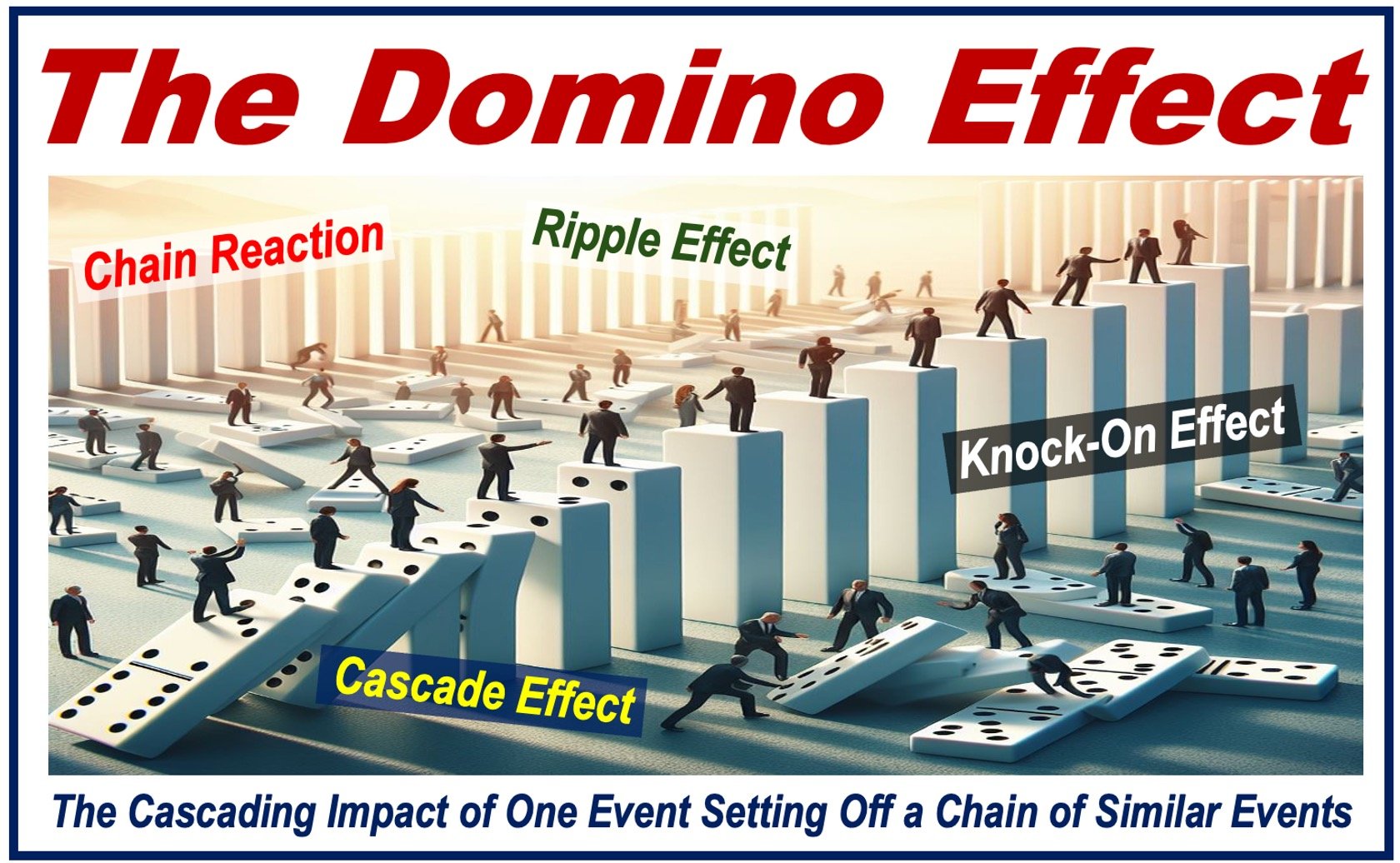The Domino Effect, also known as the Chain Reaction, Ripple Effect, Knock-on Effect, or Cascade Effect, refers to a series of events that were caused by one initial trigger. It is the cumulative effect produced when one event sets off a chain reaction, that is, a series of related events.
Imagine lining up a set of twenty-eight dominoes in a row. If you push the first one over, it will knock the next one over, and the next one will do the same, and so on, until all the dominoes topple in succession. The domino effect is an analogy of this visual but in real-world situations.
The Cambridge Dictionary explains the meaning of “the domino effect” below, and also includes an example sentence with the term:
“1. The situation in which something, usually something bad, happens, causing other similar events to happen. 2. The situation in which one event causes a series of related events, one following another. Example Sentence: ‘The collapse of a bank could have a drastic domino effect on other financial institutions.'”
Real-world scenarios
The domino effect can occur in various contexts: environmental, economic, social, political, psychological, and health-related, among others. Let’s take a look at three of them:
-
Innovation
A single innovative piece of technology can disrupt markets, causing consumer behavior to shift, and influence the global economy, all stemming from that first successful application.
The introduction of the smartphone, for example, revolutionized the telecoms industry and several others. It made many devices obsolete, such as GPS devices, MP3 players, and standalone cameras.
The smartphone also changed consumer behavior towards a preference for digital and mobile solutions. The domino effect reached global proportions by spurring new industries like app development and mobile advertising.
-
Natural disasters
A natural disaster in one part of the world can have cascading effects on supply chains which affect food prices and availability worldwide.
-
Business, finance, and the economy
A rumor can lead to a bank run, which can bring down a major bank, leading to other bank runs, which cause the stock market to crash, leading eventually to a serious financial crisis that can spread internationally.
This kind of cascading effect shows how interconnected and sensitive the banking and financial systems can be to public perception and confidence.
A bank run occurs when a large number of customers start withdrawing their money from the bank because they have lost confidence. Some bank runs have had devastating effects, bringing banks to their knees, and sometimes even causing bankruptcies.
This description of a major incident in 1907 comes an article published by Market Business News about financial crises:
“During the Panic of 1907, also known as the Knickerbocker Crisis, a number of bank runs in the United States over a three-week period caused the New York Stock Exchange to suddenly fall almost 50%. Panic spread across the country, resulting in a serious financial crisis.”

Minor actions may have major consequences
A small action or change might seem insignificant in isolation, but its potential impact could be massive when part of a larger system. Understanding the domino effect, its components, and possible consequences is vital for decision-making, whether in personal life, business, or government.
Positive scenarios
The domino effect is not solely a cautionary tale of unintended negative consequences. It may also embody the potential for positive change.
For example, one community’s effort to recycle more and reduce waste may inspire neighboring communities to adopt similar practices. The ripple effect that the first community triggered may lead to widespread environmental benefits.
Similarly, acts of kindness and community support can inspire others, spreading solidarity and positivity.
Predicting domino effect outcomes
Domino effects are the result of a complex interplay of variables, making it extremely difficult to predict their outcomes. However, being aware of how they can develop may help in the decision-making of individuals, companies, and local and national governments.
Conclusion
The domino effect is a metaphor for the interconnected and cascading impact of events that are triggered by a single action or event. It emphasizes the significance of considering the broader consequences of our decisions or actions.
